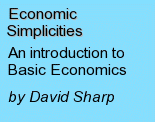




Introduction to Economics Lesson 07 / 08
RICE
Rice is a
grain, produced by a grass. It
is widely considered to be the world’s most important agricultural
product; more than half of the population of the planet relies on it for
its staple food, eating it at least once per day.
It is grown in over 100 countries, including Australia.
In many countries, such as Cambodia, Bangladesh and Myanmar, it
is the primary source of protein for the bulk of the population.
In a number of languages the word for rice is a synonym for food;
in Chinese, for instance, to ask if someone has partaken of food, one
asks if he or she has eaten rice. In
recognition of its economic and cultural significance, the U.N. declared
2004 to be the International Year of Rice.
The top three
rice producing countries in 2004 were China [26%], India [20%] and
Indonesia [9%]. Most rice
is consumed in the countries in which it is grown. Only a relatively
small proportion of the world’s production is available for
international trade. In
recent years, of the approximately 600 million tonnes produced annually
worldwide, only 25 million tonnes annually were traded internationally.
The leading two exporting countries are Thailand and Vietnam,
which between them typically supply almost half of world exports.
The USA and Australia are exceptions; relatively small producers
but significant exporters, supplying approximately 11% and 4% thereof
respectively.
Presently,
for a variety of reasons there is a crisis in the worldwide rice
industry; consumption is exceeding production, productivity growth is
declining, stockpiles are down, the introduction of new technology has
stalled, the volume available for international trade is falling, and
prices are going through the roof.
The spectre of large scale, widespread hunger, if not actual
famine, looms.
The Australian Industry
Rice was first grown in Australia in 1914. The first commercial crop was grown in 1924 by 8 farmers around Leeton and Griffith in the Murrumbidgee Irrigation Area, who saw the cheap local land, [too heavy for fruit and too infertile for wheat], as being suitable for rice. They formed a collective the following year.
In 1927 the Australian government enacted a protective tariff. This led to disputes with the millers who wanted to import cheap overseas rice. The growers then successfully enlisted the aid of the NSW government; a marketing board was set up, which favoured the growers and eventually led to them controlling ricemilling.
Following its inception, rice developed eventually to become, by the turn of the century, Australia’s third biggest grain and ninth biggest agricultural export, the overwhelming bulk thereof being produced in NSW in the Riverina region, with a small amount from the Goulburn valley region of Victoria, south of the Murray. It also became the country’s most government regulated and assisted agricultural industry.
The Australian rice-growing industry lays claim to being the most efficient in the world, including having the highest yield per hectare and the lowest water use, and to contribute to the economic support of 63 regional towns. An adequate supply of water, however, is a sine qua non for successful rice-growing. Attempts to grow rice in the well watered, tropical north have consistently failed due to unsuitable soils and natural pests. Water in the Riverina is relatively scarce. Critics of the industry point out that the value of the rice produced barely exceeds the value of the water consumed in its production. Without government assistance it is unlikely that rice-growers would be able successfully to compete against bids from other would be users of the water.
Presently, the Australian rice industry is struggling to survive. Until the early 2000s the industry generated approximate earnings of $800 million from a crop of about 1.2 million tonnes, with approximately $400 million coming from the 85% of the crop that was exported. However the drought that has gripped the area since 2003 and constraints on water use has seen production levels plummet to a predicted level this year of 15,000 tonnes. Rice mills have been closed or placed on care and maintenance. Producers generally, faced with a lack of water and under increasing attack from environmentalists and conservationists, who perceive the industry as a threat to the eco-system, are leaving the industry.
The World Industry
As producers of the staple food of the bulk of so many countries’ populations, rice industries generally have always been subject to political intervention and pressure. Governments have had to cope with and balance the conflicting demands of cheap food for the masses, and enabling an adequate return to the producers. In doing so, governments have frequently intervened in and controlled the workings of the market.
Rising populations and increasing incomes have led to increased demand for food, including rice. Natural disasters such as the drought in Australia have curtailed production, placing strain on existing supplies. Alternative uses for rice-growing land, such as the production of bio-fuels and urbanization have decreased its availability and increased its price. Worldwide inflation has occurred. As a consequence, in the last few years the price of rice has tripled. For those attempting to survive on a subsistence income this is a disaster.
In the 1960s, the so-called Green Revolution, through technological innovation, dramatically increased yields and overall production. Technological innovation, particularly the creation of new varieties by so-called genetic engineering, is now however subject to strenuous, often violent opposition from those who perceive it to be a threat to the environment.
As stockpiles have run down, many governments in an endevour to maintain their own country’s supply and to prevent internal food prices from rising, have placed an embargo or excise on exports. The affect however has been to deprive their own producers of the benefit of increased prices and of the incentive for them to increase supply. Predictably such remedies are doomed to fail.
David Sharp
3 June 2008